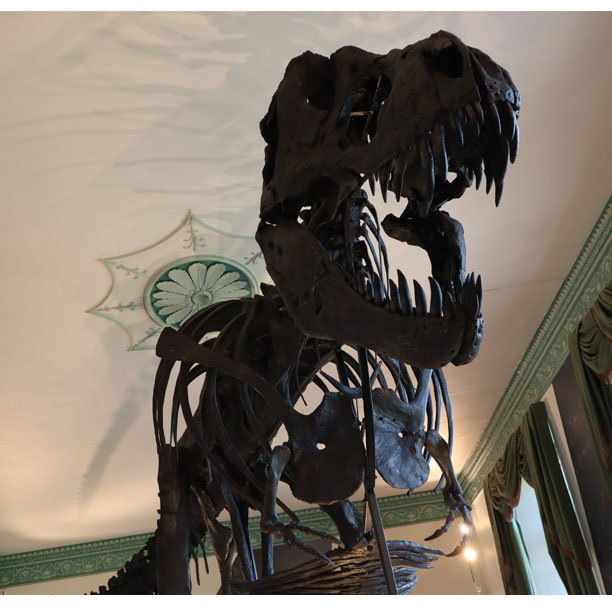We have just finished reading the latest edition of “Prehistoric Times” magazine. Issue 151 features the artwork of Esther van Hulsen on the front cover. Inside, readers will discover what inspired the artist to paint an adult and juvenile Hypacrosaurus. The beautiful illustration of this pair of duck-billed dinosaurs was commissioned to celebrate the arrival of the fossilised remains of a juvenile Hypacrosaurus at the Natural History Museum of Norway. Last year, an adult Hypacrosaurus specimen was acquired by the Museum. The adult will now be joined by the juvenile. They form part of an exhibit highlighting dinosaur nesting behaviour and ontogeny.
More details can be found in the extensive news section inside issue 151. In addition, the news section features the recently described ceratopsian Lokiceratops, and Fona herzogae, a Late Cretaceous ornithischian dinosaur that may have lived in burrows. This is an example of fossil specimens indicating that they represent an animal that may have been fossorial.

The front cover of “Prehistoric Times” magazine highlights ornithischian parenting as illustrated by Esther van Hulsen. This is issue number 151 (autumn 2024). Picture credit: Mike Fredericks.
Picture credit: Mike Fredericks
The magazine also features news about a new duck-billed dinosaur from Mexico Coahuilasaurus lipani.
To read more about this remarkable discovery: A New Hadrosaur from Mexico is Described.
“Prehistoric Times” and Prehistoric Elephants
Recently published research (Hauffe, Cantalapiedra and Silvestro) suggests that the extinction rate of proboscideans was accelerated by the emergence of modern humans. More information about this study can be found inside “Prehistoric Times” magazine. This provides a neat segue into the latest article in the long-running series by John Lavas documenting the incredible artwork of Zdeněk Burian. Part thirty discusses the Czech artist’s work on basal proboscideans. Look out for some stunning oil paintings of early prehistoric elephants!
The intriguingly entitled “Paint Strokes in Time” re-imagines how prehistoric animals might have been depicted if great artists and sculptors of yesteryear had been able to access modern science. Today’s palaeontology informing their works and artificial intelligence being employed to create stunning art. Part two of Alain Omer Duranceau’s imaginative project will feature in issue 152.
Tracy Lee Ford embarks on a comprehensive review of feathers in his regular “How to Draw Dinosaurs” article. This is going to be a most informative series if part one is anything to go by. The author admits that some of the areas he intends to cover might be controversial. We look forward to reading more of his insights and observations.
Editor Mike Fredericks reviews ten books in the “Mesozoic Media” section. It is pleasing to see Michael Benton’s fifth edition of “Vertebrate Palaeontology” reviewed along with Dr David Hone’s “Uncovering Dinosaur Behavior”. Dr Hone has contributed an article to the magazine. He examines the tricky problem of estimating the size of dinosaurs. This topic has inevitably been an area of much debate and discussion amongst palaeontologists. Is the hypothetical maximum length for a Tyrannosaurus around fifteen metres?

The spectacular Titus the T. rex exhibit at Wollaton Hall. A theoretical size for Tyrannosaurus rex is proposed in an article written by Dr David Hone. Picture credit: Everything Dinosaur.
Picture credit: Everything Dinosaur
Maraapunisaurus – A Mysterious Giant
Regular contributor Phil Hore collaborates with American palaeontologist Kenneth Carpenter to tell the story of Maraapunisaurus fragillimus. They explain how the dinosaur originally known as Amphicoelias came to be scientifically described and highlight what it tells us about gigantism and dinosaur evolution.
Our congratulations to the readers whose artworks were used to illustrate this article. Samuel Pickens provided a close-up view of the head along with artwork showing the entire animal reconstructed. Tim Bollinger contributed an illustration and Eivind Bovor depicted a pair of these giant sauropods feeding on Araucaria. Moreover, Victoria Grabowsky portrays the size of Maraapunisaurus by including a trio of theropod dinosaurs harassing this leviathan. We appreciate all the illustrations that are submitted to the magazine. A special mention goes to M. Elliot Massion for submitting not one but two illustrations.
From a mysterious giant to a mysterious island. John F. Davies muses on the monsters portrayed in the 1961 movie “Mysterious Island”. The film, loosely based on the Jules Verne novel, provides plenty of scope for master animator Ray Harryhausen to showcase his skills. The mainly British cast have to contend with an enormous ammonite, killer crabs and a “Terror Bird”. All these fantastic creatures were brought to life by Ray Harryhausen and his stop-motion animation skills.
Sculptor Sean Cooper is interviewed and some of his spectacular creations are shown including a “Terror Bird” figure (Titanis). Randy Knoll updates us on new model introductions. He looks at new CollectA, TNG and figures aimed at the Japanese market. Editor Mike Fredericks reviews a new ichthyosaur exhibition in Reno (Nevada) and John Lavas steps away from his work documenting Burian to bring us an interview with Dr Darin Croft, an expert on South American megafauna.
Lungfish in “Prehistoric Times” Magazine
The Sarcopterygii take centre stage as Phil Hore highlights the evolutionary history of lungfish. He outlines the remarkable contribution made to science by Johann Ludwig Gerard Krefft, the Australian Museum siege notwithstanding. Congratulations to Russell J Hawley for his excellent illustrations, one of which reveals the chelicera of an eurypterid. Aaron Marsh depicts a pair of theropod dinosaurs encountering a lungfish and regular contributor Chuck Egnaczak portrays a lungfish during aestivation.
What a bumper edition issue 151 has turned out to be. Our congratulations to everyone involved in this superb magazine.
To learn more about “Prehistoric Times” magazine and to subscribe: Subscribe to “Prehistoric Times” Magazine.


Leave A Comment